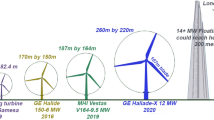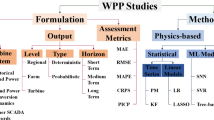Abstract
Many researchers presented the theoretical analysis of the doubly fed induction generator (DFIG) based wind turbines, while the experimental setup is more valid but remains a big challenge. Besides, wind power systems' most significant problem is how to get the most valuable energy with different wind speeds. Using wind speed sensors is a challenging operation in wind turbines due to the complicated maintenance and high cost. Therefore, This paper proposes an efficient and usable control system based on the WSE method to achieve the MPPT from DFIG under variable wind speed in different conditions. This paper also presents a DFIG based wind turbine as simulation and experimental investigation models. The simulation model of DFIG with their control schemes is implemented in MATLAB/SIMULINK software. While the experimental model is performed on a real prototype scale. Finally, a comparison of the simulation and experimental results was carried out to prove the practicability and validity of the proposed WSE method. Also, the simulation results show that the performance of the proposed WSE method is better than the traditional power signal feedback method.




















Similar content being viewed by others
References
Gualtieri G (2019) A comprehensive review on wind resource extrapolation models applied in wind energy. Renew Sustain Energy Rev 102:215–233
Yang L, Xu Z, Ostergaard J, Dong ZY, Wong KP (2012) Advanced control strategy of DFIG wind turbines for power system fault ride through. IEEE Trans Power Syst 27(2):713–722
Yin M, Xu Y, Shen C, Liu J, Dong ZY, Zou Y (2017) Turbine stability-constrained available wind power of variable speed wind turbines for active power control. IEEE Trans Power Syst 32:2487–2488
Ngamroo I (2017) Review of DFIG Wind turbine impact on power system dynamic performances. IEEJ Trans Electr Electron Eng 12:301–311
Alaboudy AHK, Azmy AM, Abdellatif WSE (2015) Controller performance of variable speed wind driven doubly-fed induction generator. In: IEEE Saudi Arabia Smart Grid (SASG) Conference 7–9
Youssef A, Hossam HH, Essam M, Mohamed EM (2020) Development of self-adaptive P&O MPPT algorithm for wind generation systems with concentrated search area. Renew Energy 154:875–893
Kumar D, Chatterjee K (2016) A review of conventional and advanced MPPT algorithms for wind energy systems. Renew Sustain Energy Rev 55:957–970
Dessouky SS, Abdellatif WSE, Abdelwahab SAM, Ali MA (2018) Maximum power point tracking achieved of DFIG-based wind turbines using perturb and observant method. In: 2018 Twentieth International Middle East Power Systems Conference (MEPCON), Cairo University, Egypt
Sachan A, Gupta AK, Samuel P (2016) A review of MPPT algorithms employed in wind energy conversion systems. J Green Eng 6(4):385–402
Ananth D, Kumar GVN (2016) Tip speed ratio based MPPT algorithm and improved field oriented control for extracting optimal real power and independent reactive power control for grid connected doubly fed induction generator. Int J Electr Comput Eng (IJECE) 6:1319–1331
Qiao W, Zhou W, Aller JM, Harley RG (2008) Wind speed estimation based sensorless output maximization control for a wind turbine driving a DFIG. IEEE Trans Power Electron 23(3):1156–1169
Fateh F, White WN, Gruenbacher D (2015) A maximum power tracking technique for grid-connected DFIG-based wind turbines. IEEE J Emerg Sel Top Power Electron 3(4):957–966
Yang B, Zhang X, Yu T, Shu H, Fang Z (2017) Grouped grey wolf optimizer for maximum power point tracking of doubly-fed induction generator-based wind turbine. Energy Convers Manag 133:427–443
Blaabjerg F, Chen Z (2006) Power electronics for modern wind turbines. Synth Lect Power Electron 1(1):1–68
Shin H-S, Xu C, Lee J-M, La J-D, Kim Y-S (2012) MPPT control technique for a PMSG wind generation system by the estimation of the wind speed. In: 2012, 15th International Conference in Electrical Machines and Systems (ICEMS), pp 1–6
Belmokhtar K, Doumbia M, Agbossou K (2011) Modelling and power control of wind turbine driving DFIG connected to the utility grid. In: International Conference on Renewable Energies and Power Quality (ICREPQ’11), Las Palmas de Gran Canaria (Spain), 13–15
Author information
Authors and Affiliations
Corresponding author
Additional information
Publisher's Note
Springer Nature remains neutral with regard to jurisdictional claims in published maps and institutional affiliations.
Rights and permissions
About this article
Cite this article
Abdellatif, W.S.E., Hamada, A.M. & Abdelwahab, S.A.M. Wind speed estimation MPPT technique of DFIG-based wind turbines theoretical and experimental investigation. Electr Eng 103, 2769–2781 (2021). https://doi.org/10.1007/s00202-021-01268-8
Received:
Accepted:
Published:
Issue Date:
DOI: https://doi.org/10.1007/s00202-021-01268-8




